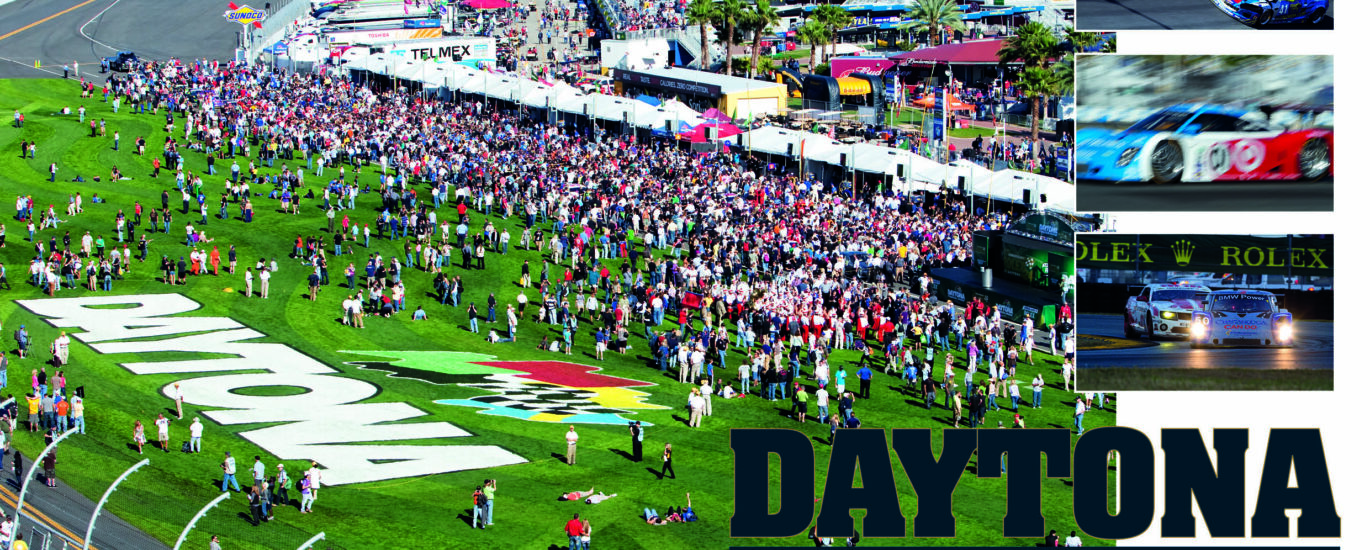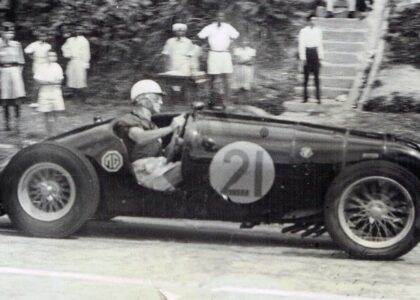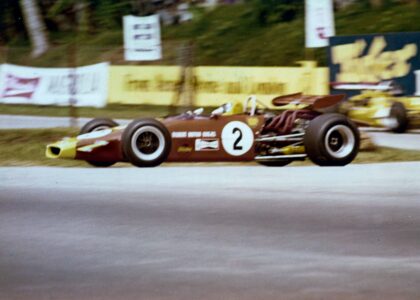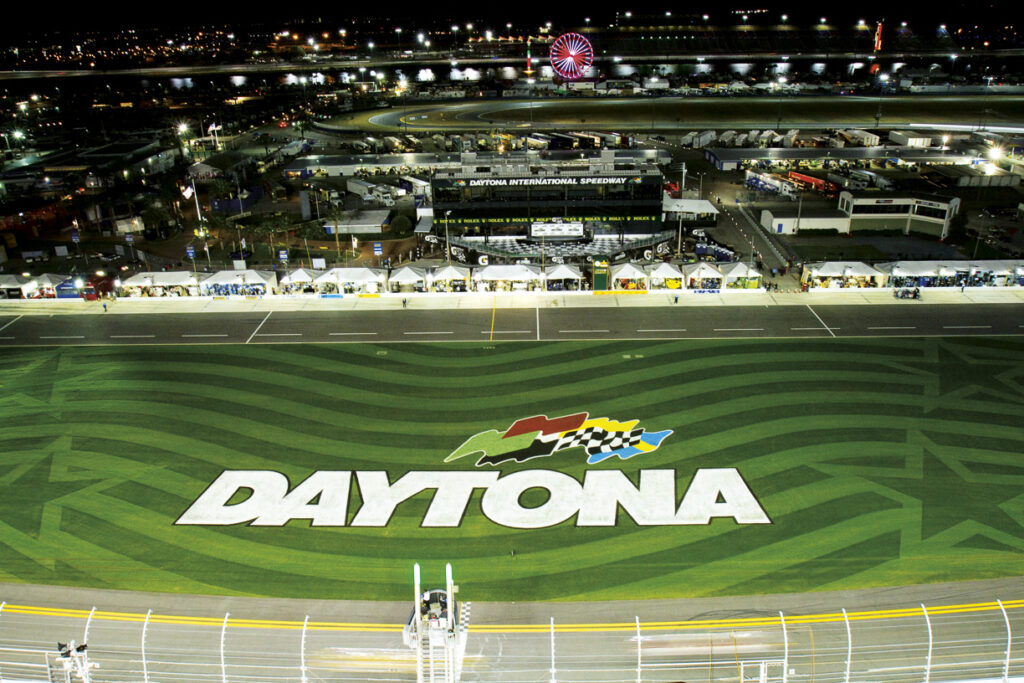
As we head into another potential lockdown in our little village, the only way I know of how to beat local Covid-19 restrictions is to dig up the old Rewind Magazine archives and upload more “happy” content. And since it’s Speed Week at Daytona, what better way than to look back at my visit to Florida in 2013 – for the 50th anniversary of North America’s most prestigious Sports Car race.
Daytona International Speedway is quintessentially the soul of America’s irrepressible craze for speed and motor sport, and the Rolex 24 At Daytona, the season opener, is its most anticipated event. The 50th anniversary of North America’s most prestigious Sports Car race was the perfect reason for us to be there.
Growing up on a weekly dose of ABC’s Wide World of Sports gave me an insight into America’s love affair with sports. Coupled with the better-selling motoring magazines out of the US such as Hot Rod Magazine and Road & Track, I grew up thinking that motor racing was all about NASCAR and drag racing. Alongside this rip-roaring rarefied culture of nitrous oxide and methanol, there was, I later discovered, an equally strong following of sports car racing at circuits with glorious sounding names such as Daytona, Riverside, Sebring and Watkins Glen. Racers such as Andretti, Gurney, Hill, Hall, Foyt, Yarborough and Waltrip kept me enthralled and inspired my doodling in school that filled my jotter books with race cars that looked futuristic and unbuildable.
SPACE CADET
It is freezing in Detroit, our body clock has been wound silly, and we have gained a day. I want to head straight for Woodward Avenue to get a sense of what Jim Wangers was talking about in his autobiography, Glory Days, when Pontiac GTOs and Bobcats ruled the roost. A quick switch of aircraft beckoned however, the third in 24 hours, this time headed for Orlando, Florida. The idea was to get to Daytona before nightfall on Wednesday. The opportunity of visiting the mecca of world racing would then be an hour and a half away by car.
Orlando, Florida, home to Disney World’s Epcot theme park, also the last stop for those wishing to visit Cape Canaveral and the Kennedy Space Centre which is celebrating 50 years of space exploration this year, is where we will not be lingering. A few, like us, are taking the highway to Daytona Beach for something more down to earth, to the Speedway and the Rolex 24 At Daytona.
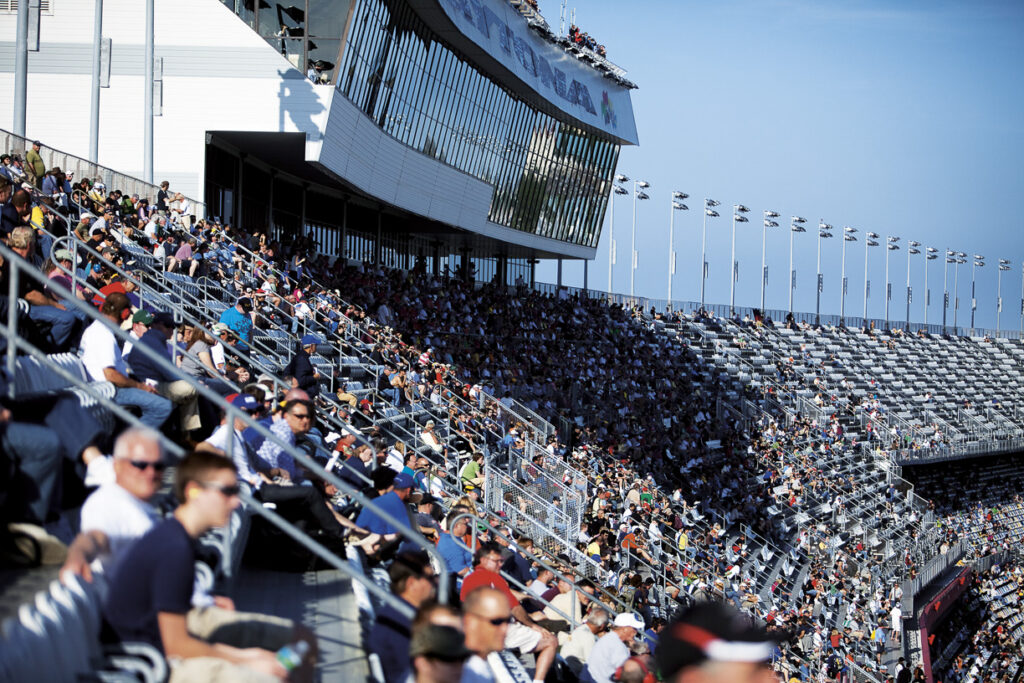
NORTH AMERICA’S BEST
The Daytona International Speedway’s first event in 1959 was a non-points club race held on the newly-constructed oval and infield. By 1962, the race had taken on an international status and was run over three hours. Competing for the win were Formula 1, Indianapolis and NASCAR drivers and, that year, the race was won in dramatic fashion by American racing legend Dan Gurney. By 1964, the Daytona Continental, as it was then called, evolved into a 2,000km race. The race was extended to 24 hours in 1966, and has remained that way since.
Today, the two main classes in the endurance race are the 500 bhp GRAND-AM Daytona Prototypes and production-based GTs. The Rolex 24 At Daytona, now famously called the Rolex 24 in deference to Rolex, the title sponsor since 1992, is the Speedway’s signature event around the street and banked circuit.

Every year, spectators pour in from all over the world. This year was significant as past champions from Le Mans to Formula 1, and NASCAR to Indy, were especially invited to celebrate the 50th anniversary of this iconic event. Amongst them were racing personalities such as Derek Bell, Bob Bondurant (where I first learnt how to race at his race school in Arizona), George Follmer, Dan Gurney, Bobby Rahal, Brian Redman and Sir Jackie Stewart.
In all, 47 of Daytona’s past winners made the trip and the organisers went out of their way to locate the cars that had won at Daytona as well. 29 of these were tracked down and transported to Florida for this extravaganza. What a feeling of euphoria to see the cars rumble by in formation along International Speedway Boulevard into the circuit to the enclosure for a special “50-years of Champions” exhibition. We stood in awe from the vantage of Daytona’s Sprint Tower as the purpose-built ’66-winning Ford GT40, the evocative and curvaceous ’69-winning Lola T70 and the best-known Porsche endurance racer of all time, the 917K, rolled round the banking in procession.
It is refreshing and inspiring to see that heritage and history are a big part of the scene here, an undertaking, it seems, aptly suited to the Public Relations team headed by the affable Lenny Santiago, its Senior Director. “It’s impossible to explain yet capture everything that we do,” he said. “Problem solver, story teller, messenger, message crafter,” you can wager that Santiago and his team are working flat out to make sure everyone, from the media to the champions to the dyed-in-the-wool race fans, are catered to. “There are a lot of fires to put out around the start of the event. Usually once we get to the race, everything’s set…it’s pretty much a set plan of what we do: everyone’s settled, everybody’s got their place, they know what they’ve got to cover – This year is special,” he emphasised.
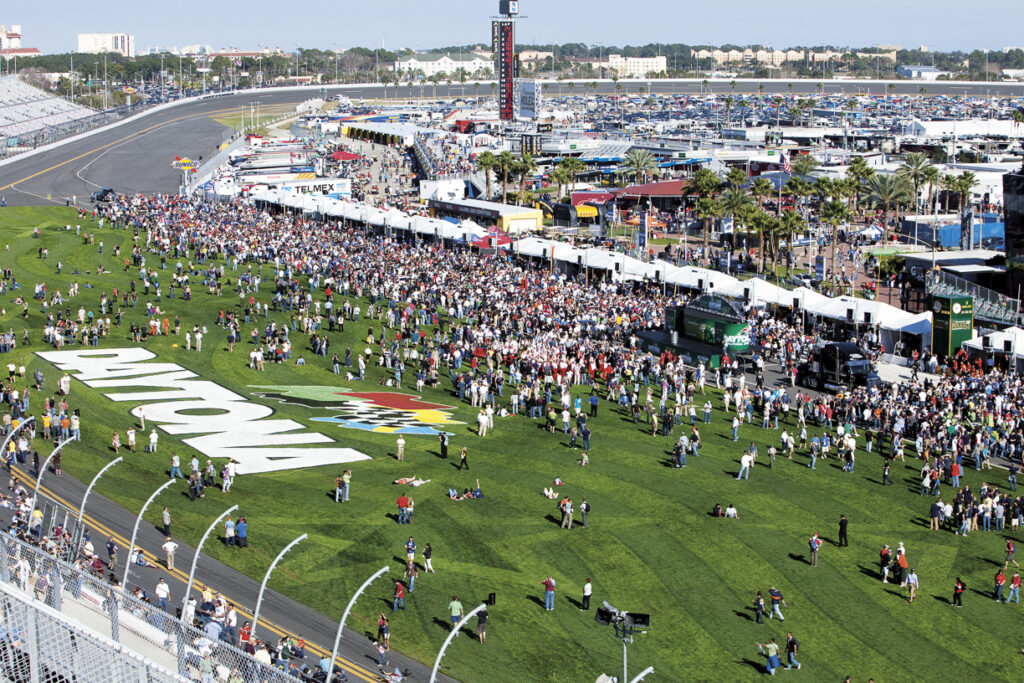
Media attendance was an impressive and unprecedented turnout in the history of the event. Arrive late and there was no wire to transmit from, let alone a stool to sit on. Andrew Gurtis, Vice President of Operations for the event, was pleased with the turnout; he had not seen this kind of energy for this race in his 21 years at Daytona.
The strength of the grid at the Rolex 24 is testimony to the strength of the sport in America. Renowned racing names such as Andretti, Bell, Donohue, Earnhardt, Fittipaldi, Gurney, Rahal, Sharp and Waltrip, to name but a few, continue to feature as competitors from the second and third generation of racers whose parents and uncles had been at the top of their respective classes. Along with Allan McNish, Justin Wilson and the ubiquitous and almost mercurial Juan Pablo Montoya, it is gratifying that the former Formula 1 fraternity are also active in NASCAR, endurance and circuit racing. From our neck of the woods were the familiar faces of Matthew Marsh and Darryl O’Young flying Hong Kong’s bauhinia for Asia in a Chevy Camaro and Porsche respectively.
For sports car aficionados, the Rolex 24 is the place to be, and over the next four days, I too was bound up in America’s love-affair for speed.
INFIELD OVERLOAD!
Let loose around the circuit, Paul, our crack sharpshooter, and I went our separate ways, he to capture the illusive cover shot and photos for what you see on these pages, and I to the merchandise area in the infield. The roles were reversed at some point on Saturday as I was scouting around the pit garages.
“Come quick, there’s a guy who was with the RAF Changi in Singapore and is selling Singapore GP T-shirts. Old stuff,” read an SMS. Fortunately, the 61-ha infield is mainly flat ground – a brilliant design for any race circuit. A short walk past the ‘horseshoe’ at turn 3, a right hook by Bob Bondurant’s trailer with a C6 Corvette and Camaro on display, a tent selling cigars, a hot dog stand, and I had arrived at merchandise heaven.
Plying fast food and auto memorabilia certainly appear to be a savvy strategy of pulling in the crowds and raking in the dollars for both stall operators and the circuit. We were not alone. The infield was swarming with ebullient fans ready to empty their wallets, and the queue was long to snag that Rolex 24, Brabham, Lotus or JPS embroidery patch and sticker. One simply needs to look beyond the grandstands to appreciate where everyone had disappeared to. The Speedway’s sun-soaked infield was a hive of intense activity all weekend. If burgers or hot dogs did not appeal to the palate, there were stalls selling fries, nachos, beer and cigars, and numerous official merchandise outlets that ran out of what you wanted if you so much as dithered.
LET EM’ ALL GO!
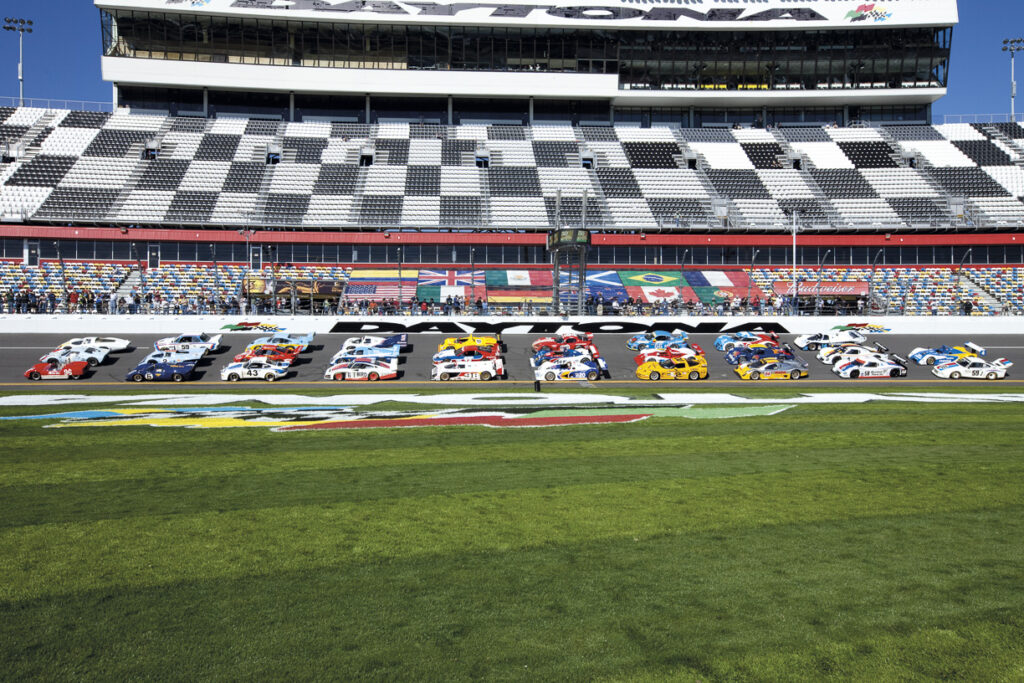
The Grand Marshal’s highly-anticipated call of “Gentlemen, Start Your Engines” is surely the most resonant rallying cry in American motor sports. It was not just the race teams that were intently gearing up as the start of the race approached. Photographers scrambled for strategic positions ahead of Sir Jackie Stewart’s command to fire up the engines. The doctors had not allowed A.J. Foyt out of hospital a second time after orthopaedic surgery, so it was this Scotsman, Rolex ambassador and three-time Formula 1 champion who flagged the start of the race. Under mid-afternoon Florida-blue skies and a comfortable 69oF (20 Celsius), in undertones of NASCAR-like drifting and wheel-banging, an ultra-competitive grid of 59 racing cars thundered by on the banked oval for what was essentially going to be an all-out 24-hour sprint to the finish.
Up in the Sprint Tower overlooking the start-finish line sits the irrepressible John Hindhaugh. As the front-running Corvettes, BMW/Riley and Ford/Riley DP cars jostled for position, Hindhaugh, the unmistakably familiar voice of Radio Le Mans, gave us the blow-by-blow account of the race. What was the Radio Le Mans team doing at the Rolex 24?
LIVE TALKIN’
“I first came to Daytona to see a stock car race fifteen years ago,” Hindhaugh rattled off during an interlude in a strong North-Eastern accent. He has been back for the event over the last five years. His team produces a retrospective on the racing that is broadcast over the net, but this year was seminal – they were going live.
“We’re getting quite used to finding our way around here, but we’ve never done any live broadcasting from here before,” he said as he regaled me with technical issues they had encountered during the lead-up to race day. “We started on Wednesday night and we did the mid-week motor sports show partially from here [the media centre]; we did the live broadcast from the press room…[it will be] about 10 hours of live broadcasting before we even get to race day.” They overcame difficulties with broadband lines by falling back on Skype and a laptop. All water off a duck’s back for Hindhaugh and his small team of five.
VICTORY LANE
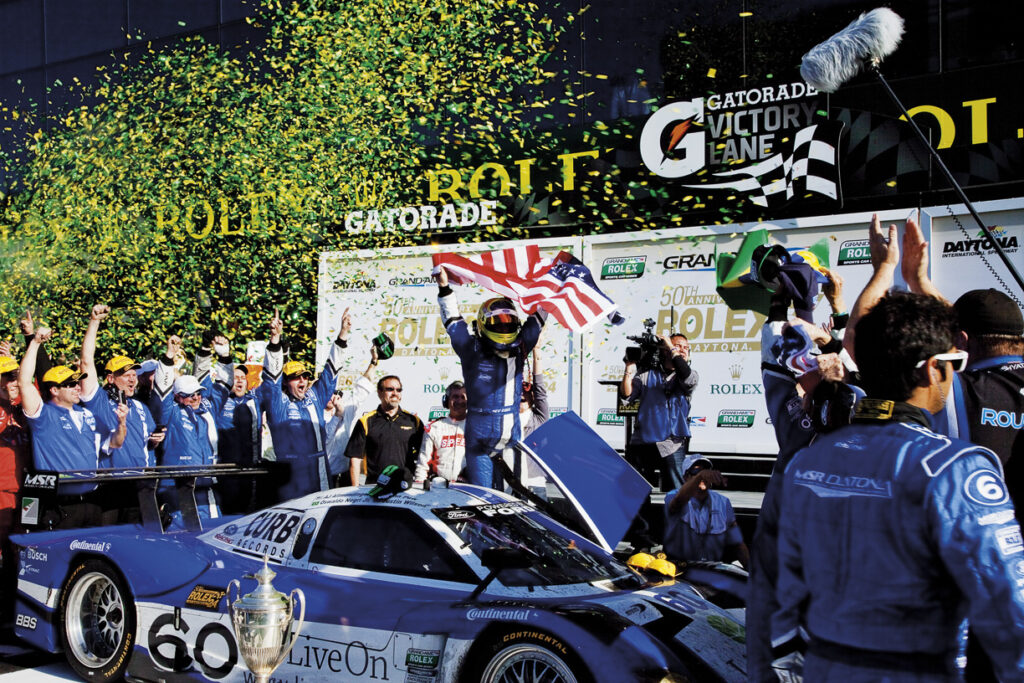
Americans have showmanship down to an art, and nothing beats the victory lane celebration, in this instance, the culmination of twenty-four hours of riveting racing. As photographers and fans scrambled for position on Victory Lane, I decided a bird’s eye view would be less traumatic and made my way to the roof of the Champions’ Club. It was not difficult to locate a spot that would give me a panoramic view of the closing stages of what was an epic race for Michael Shank Racing’s A.J. Almendinger/ Justin Wilson/John Pew/Ozz Negri Jr. Almendinger took the chequered flag, exhausted after a nearly three-hour stint, the final stages featuring door-to-door banging, numerous changes to the lead and some poor luck for Chip Ganassi’s star-studded BMW/Riley squad of Scott Dixon/Juan Pablo Montoya/Dario Franchitti/Jamie McMurray (they finished fourth).
As I wedged myself against the parapet to capture the explosion of confetti four floors below me, a grizzly 6ft-5in gentleman with white beard nudged me as he tried to get in next to me. “First time here,” he drawled. “Man, this is awesome,” the big guy grinned through tobacco-stained teeth. I murmured the same, told him where I was from and continued shooting. The atmosphere below was charged. “Bet they don’t have buildings in Singapore,” he grinned. Fancy that. “Yes, you’re right. We live in attap huts and bathe in rivers,” I replied as Almendinger emerged victorious and exhausted from his Ford/Riley. He continued to grin, with an expression that suggested he understood me perfectly. “I was only being American,” he chortled. Victory Lane erupted, a cloud of confetti filling the air with loud cheers and a blaze of colour. We hit it off after that, my new friend and I.
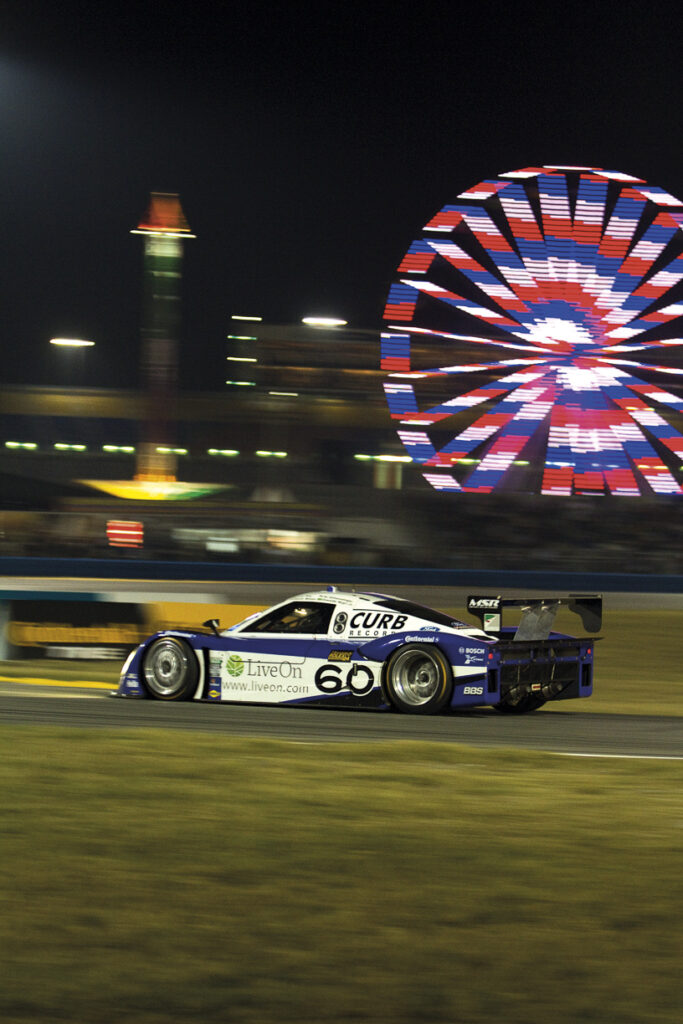
Interview With Joie Chitwood III – The Daytona Way
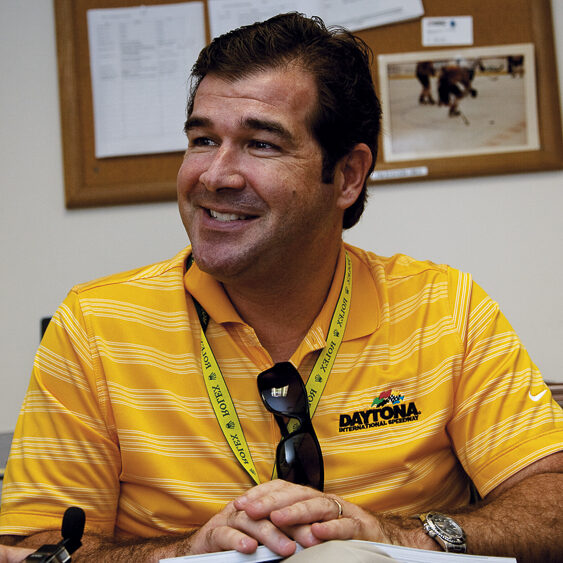
Daytona’s Speedway is the entertainment model even the American National Football League and Major League Baseball have tried to emulate. With the uncertain American economic climate, circuit owners were just as vulnerable as the toppling retail sector. The International Speedway Corporation has, however, a strong team in place which has embraced change by enhancing value at its racetracks, improving its race-day product, and increasing its advertising budget. An invitation to meet with the President of Daytona International Speedway, flagship of International Speedway Corporation, was therefore warmly accepted.
RW: Many of our Asian readers are unfamiliar with the very successful business model and the corporate structure of Daytona International Speedway and the International Speedway Corporation. Please tell us more.
JC: Daytona International Speedway is one of 12 race tracks owned by the International Speedway Corporation (ISC). ISC is a public company that has been in the motor sports business for a number of years. It was founded by the France family, the same family that founded NASCAR. `Big Bill’ France built this property in the late 1950s. He moved racing from the beaches to the high banks of Daytona, and so we’ve been doing this for over 50 years. In a couple of weeks, we’ll hold our 54th annual Daytona 500. As they’ve changed their business model, they have acquired other properties and have gone public in the meantime.
ISC, or Speedway Corporation, trades under the symbol ISCA on NASDAQ with a market capitalisation of over USD1.2b. It is one of the most profitable companies under the Leisure Services sector in the US stock market. For a better understanding of the history of the France family, NASCAR, and the magic behind Daytona, read H.A. Branham’s book, ™Bill France Jr ± The man who made NASCAR∫, Triumph Books, 2010.
RW: Tell us about yourself.
JC: I’ve been around motor sports for really my whole life, my family as well. My dad raced in the Rolex 24, my grandfather raced in Indianapolis. This is my life, this is what I know how to doº I do not race, although I grew up in my family’s stunt show business. I actually spent 20 years of my life driving cars on two wheels, jumping cars, wrecking cars. That was my relationship to motor sports. My dad and my grandfather both raced at points in their career, but they are known mostly for being automobile stunt men [and running the well-known Chitwood Thrill Show].
RW: The circuit has undergone some major changes over the years. Tell us about this and your involvement in the Rolex 24.
JC: Our biggest project in recent years was our repave. We embarked on a USD20 million repave in 2010/2011 of the high-banked oval, and it wasn’t just a repave. Daytona was paved for the first time in 1958, repaved in 1978, but all they did then was put two inches of asphalt on top of the old asphalt. We tore out all the old asphalt and rebuilt the whole track from the lime rock all the way through the subsurface to the surface we have now. Last year, we had some phenomenal races with the new asphalt.
I came on to the team in the middle of that project so it wasn’t just running Daytona, it was running Daytona and by the way, you need to get this paving project done on time, and on budget, and everything else with that. And then you start to throw in some of the unique things we have, such as the 50th anniversary.
RW: How long did the planning for this take and what did it entail?
JC: We started planning for the 50th anniversary celebrations about thirteen months ago. I can’t pinpoint down the exact day we sat down and said, hey, can we find all the winning cars? I know that some point in December [2010] was when we had this conversation because in January of 2011, we started talking to Tim Pendergast to help us go find them. That became our focal point…we felt that the cars, when you look through the decades and you see the changes in the aerodynamics and other aspects, told the best story. We acquired 29 of them, which is a phenomenal collection.
Tim Pendergast of Jacksonville, Florida, was hired to track down the cars that won at Daytona and obtain permission from the current owners to showcase them in the temporary building the Speedway was constructing for the 50th anniversary celebrations at the circuit. Pendergast, a vintage car expert, has worked with Speedway president, Joie Chitwood III, in the past in locating and displaying historic cars.
RW: It must be a rewarding task collating information and physically getting such a unique collection together.
JC: Some of the Porsches, the Fords, the BMWs, they’re just great in terms of telling the story of how the cars have changed. My personal favourite is the ’66 Ford GT because of the history behind that, beating Ferrari in Sports Car racing and specifically at Le Mans. Read the book, Go Like Hell [Go Like Hell: Ford, Ferrari, and Their Battle for Speed and Glory at Le Mans by A.J. Baime]. The history of that ’66 car is pretty special. I think that’s what excites people, so for us, that was the big challenge. We’ve done a really good job with the cars. We had a great charity event. We drove those cars from the Ocean Centre down at the beach to the track this morning. Great reception.
RW: It appears to have been a huge undertaking that many did not think could be pulled off.
JC: It really was, and I don’t think people understand. We had a point where we couldn’t find three cars and we had no leads on the ownership, so we issued a press release that said, `Help us find these owners.’ We actually got an owner. He called us and left a voice mail on one of our ticket numbers. He said, `Hey, I own the Ted Field Interscope Porsche if you guys want to call me.’ He was in France. The fact that we did our own version of Where’s Waldo…find this car, played out well.
The Interscope Racing Porsche 935 was driven to victory at the 1979 event by Hurley Haywood, Danny Ongais and Ted Field.
RW: Did you get the car over?
JC: It was in France, but it was too late to ship it over, but now we know moving forward who the owner is. We did that press release tongue in cheek, had a little fun with itºbut it really worked.
RW: I see the way you’ve been able to gel the strength of Daytona’s heritage with modern motor sports. It’s all around us, around the circuit, on the big screens, in the shops, the cars that have won being driven around and displayed at the specially-constructed shelter, the past-winning drivers mingling among the spectators, you really don’t need a museum here.
JC: You know, there’s so much history in racing all over the world, but obviously in the US, when you have an event that’s been here for fifty years, think about the changes that have occurred. You look at the names of the drivers who have participated…for American motor sports some of the classics include Dan Gurney, AJ Foyt, Mario Andretti, Hurley Heywood…these individuals are known for their racing, and they’ve all raced here at Daytona, and so we’ve got 47 former winners here, which I think is really special. I think our fans are going to enjoy it as well. I think this is also a great occasion where you can attract the casual fan who might know who AJ Foyt is but who doesn’t know who the current drivers are. It’s appealing because this is the 50th anniversary of the event.
RW: This is probably going to be a great opportunity to build upon the euphoria of the anniversary, isn’t it?
JC: I think it’s a great opportunity for us. As is typical with anniversaries, you usually see a spike in demand and interest. The key for us is to take it a step up and maintain that.
RW: How is Daytona Speedway and the International Speedway Corporation going to achieve this?
JC: The key for us is this reinvigoration of OEM [Original Equipment Manufacturer] support that we are seeing in GRAND AM racing. Ferrari, Audi, Porsche, Mazda, you name it, they are all racing…You have this country consuming almost more of the automotive products out there then there is. There’s a huge fan base in this country. For example, we actually have two hospitality areas this week, one for Ferrari Club of Florida, the other for Ferrari Club of America. These are clubs! When you have that and the kind of OEM support, you start to see the fan base follow that. I think the GT class this year is as close as it has ever been. The anniversary kind of helped reinvigorate that support and it’s a great time to get back into the sport. We hope this support continues so we can keep doing great things with it.
RW: We’ve talked about the circuit and what you and your team hope to achieve here, is the Daytona International Speedway a commercially viable race track?
JC: Without a doubt. Daytona is the flagship brand of both NASCAR and ISC. We’re the biggest NASCAR event – we pay the biggest purse; we have the most seats; we generate the most revenues. We are the flagship brand for the company. When you look at our calendar of events, we’ll operate at this venue over 250 days a year. We host the country’s biggest sports car race, stock car race and motor cycle race. Then you drill into the mix all sorts of other activities, private rentals, corporate days, driving experience… We also host a massive go-karting event over the holidays. Between Christmas and New Year’s, we’ll camp over 300 campers in the infield with families who bring their kids with their go-karts. If it has wheels and it goes fast, we’ll run it at Daytona.
RW: How big a team do you have running the Rolex 24?
JC: We’ve got about a hundred staff. About half of that is facility and maintenance. As an older property and a huge physical plant, we’re always working on upkeep, whether it is maintenance or landscaping. We have 146,000 seats! That upkeep on the aluminium and the steel is ongoing. We have to chase it, we have to make sure that it lives up to the expectation we all have that this is the world’s centre of racing, so when you show up here, it’s clean, it looks good, and it’s representative of our tradition and our heritage. A lot of staff to do that.
RW: What’s a day in the life of Joie Chitwood III like?
JC: A weekend like this is usually putting out fires. Typically, you can plan for an event the best you can, but there are so many unknowns that play out. We don’t have the luxury of making good the next day like a baseball or football game. We’re only going to have one Rolex 24 this year, and the next one is next January, so I have to make sure the customers and the fans experience it the right way this time because I can’t make it up for a year. No fan likes to be told that we’ll make it up next year. They want immediate gratification, so we are basically on call to try and make sure everything goes smoothly, dealing with media, making sure the champion drivers here are enjoying the experience. It’s a little bit of everything, but at the end of the day, I’m the last guy to hopefully solve the problem and fix whatever is wrong.
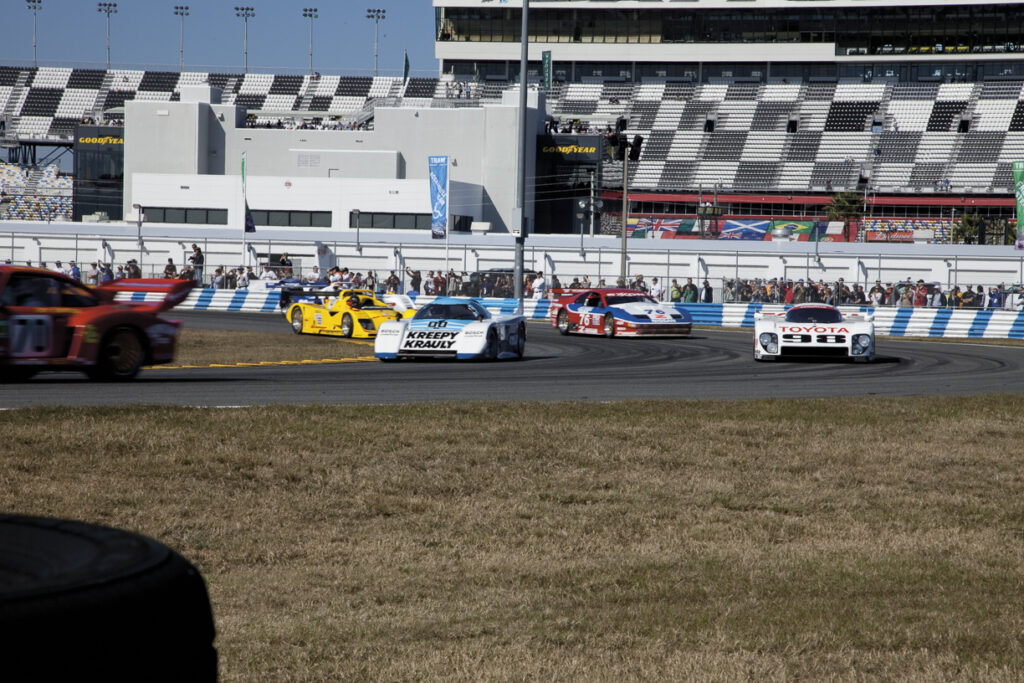
Fins
Words by Eli Solomon
Photos by Paul Khoo

